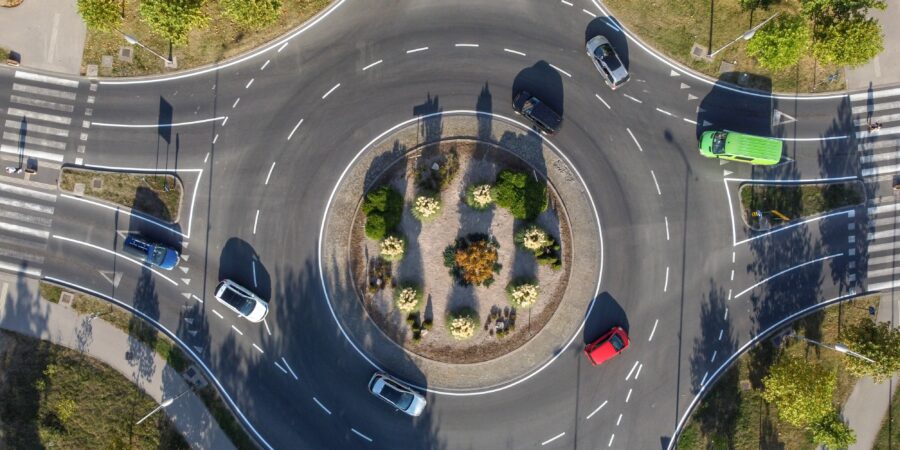While traffic circles are quite common in Europe and other regions of the world, they are not nearly as popular in the United States. In recent years, California has been expanding its number of roundabouts. These circles can reduce fatalities by up to 90 percent and injuries by 70 percent.
Although they may be safer, these traffic circles are still a common location for many accidents. Unless you want to be found negligent, it is important to learn how to safely use traffic circles. Whether you are driving in Los Angeles or San Diego, the following tips can help you stay safe on the roadways.
How to Safely Navigate a Roundabout
While a personal injury attorney can help if you are injured after a car accident, your best option is to avoid getting into a crash in the first place. In recent years, many states have built more traffic circles to accommodate a larger population. Fortunately, these traffic circles are fairly simple to navigate if you remember a few simple rules.
Yield to Oncoming Traffic
Unless you want to be found at fault in an insurance claim, you should always yield to oncoming traffic. If someone is already in the circle, you should merge behind them unless there is plenty of time to merge in front of them. Once you are in a lane within the circle, you should never change lanes because this can lead to a major car accident. You should also never stop when you are inside the traffic circle.
Be Wary of Large Trucks
Large trucks and oversized vehicles may struggle to go around the circle. If the circle is too small, the truck may unintentionally enter the lane next to it. Because of this, you should give large vehicles plenty of space as they turn.
Follow the Speed Limit
Before you reach the traffic circle, you will most likely see a sign that announces it. There will also be a sign that states the recommended speed for navigating the circle. You should always go the recommended speed. If you are driving in adverse weather conditions, you may need to go even slower than the posted speed.
Wait for a Gap
Once you see a gap in the traffic flow, you can enter the circle. If there are no other vehicles present, you do not have to wait for anyone else. While California does not require you to use a turn signal when you enter the circle, you are required to use a turn signal when you change lanes or leave the circle. You should always drive in a counterclockwise direction.
Statistics About Traffic Circles
Between 2014 and 2017, the number of traffic circles in the state’s highway system jumped from 21 to 37. In the United States, there are 73 roundabouts for every 1 million people. According to research studies, these traffic circles improve traffic flow, decrease fatality rates, and prevent pedestrian injuries.
While traffic circles might be safer than traffic lights, certain types of accidents are more likely to occur. In one study, car accident fatalities and injuries dropped by 38 percent. At the same time, the overall number of accidents increased by 12 percent.
Interestingly, about 30 to 50 percent of accidents involved a single vehicle. In many cases, this was because drivers were more likely to veer off to the side. This was especially common in bad weather.
It is important to follow California’s driving rules and posted regulations. If you get into a car accident, you may be found at fault if you were behaving in a negligent way. As a result, you could end up losing a personal injury case. In addition, negligent driving can lead to fatalities and injuries.
How Are Intersections Different?
A typical intersection is set up with traffic lights or stop signs. At large intersections, traffic lights manage the flow of traffic. In a traffic circle, drivers do not have to wait for a traffic light to turn green. Instead, they can go as soon as there is space in the flow of traffic.
Roundabouts are popular in Los Angeles and other busy areas because they provide a traffic calming effect. This naturally reduces driving speed, which can prevent accidents at intersections. Because traffic is not required to stop, the intersection can accommodate a larger number of vehicles. These traffic circles provide a number of useful benefits to cities in California.
- They reduce conflict points.
- Traffic circles naturally encourage lower speeds.
- Fewer deaths and injuries happen within traffic circles.
- Roads can accommodate more traffic.
- They reduce delays at intersections and gas consumption.
Do You Have to Signal When You Enter the Traffic Circle?
In the state of California, you are not required to signal when you enter the traffic circle. You are required to signal when you leave the circle. Likewise, you must use your turn signal if you need to change lanes.
Can You Go Around the Circle Multiple Times?
Technically, there is no law about how many times you can go around the circle. At the same time, you want to be cautious about how you drive. If you go around the circle more than twice, a police officer may fine you for careless driving. They may also pull you over for driving under the influence.
Sometimes, you may need to go around the traffic circle more than once. In these cases, you should continue around the circle one more time. When you reach your exit, you should leave the traffic circle.
Are Traffic Circles Safer?
Crashes may still occur, but traffic circles are generally much safer than traditional intersections. Other than reducing injuries and fatalities, traffic circles cut delays by 89 percent. Additionally, vehicles have to stop 56 percent less often.
How Do Accidents Happen?
Accidents can occur for many reasons. A driver may be uncertain about whether they have to yield, or they may be confused about excessive merge points. Driving too fast or trying to cut across lanes can also lead to accidents.
While traffic circles are safer for drivers, pedestrians may be less safe. Pedestrians can become injured if the shoulder is too narrow. In addition, many traffic circles do not have sidewalks.
Weather plays a role in causing many accidents. Because these circles involve a continuous turn, drivers may skid out of the circle during icy or snowy weather. Plus, trucks and large vehicles may struggle to make narrow turns without encroaching on other lanes.
What Should You Do If You Get in a Car Crash?
While your goal is to navigate the traffic circle as safely as possible, accidents can happen. If you are in a car accident, you should pull over to a safe place as quickly as possible. Then, you can see how much damage has been done to your car. You should also see if anyone has been injured.
Afterward, you should call the police to report the incident. You are required to report accidents within 10 days. Since you may need documentation for a personal injury case in the future, you should take photographs of the damage and record contact information from anyone present. Later on, this information can support your insurance claim or personal injury lawsuit.
You should never leave the scene of an accident. Other than being legally obligated to report the crash, you may need the police report for your insurance claim or personal injury case. You should only leave if you need medical attention or cannot safely remain at the crash site.
Get Help With Your Personal Injury Case Today
If you or a loved one has suffered from a roundabout accident, a personal injury attorney can help. With the assistance of a skilled lawyer, you may be able to prove that you are not at fault for the accident. To get a free consultation and explore your legal options, reach out to JT Legal Group today.


